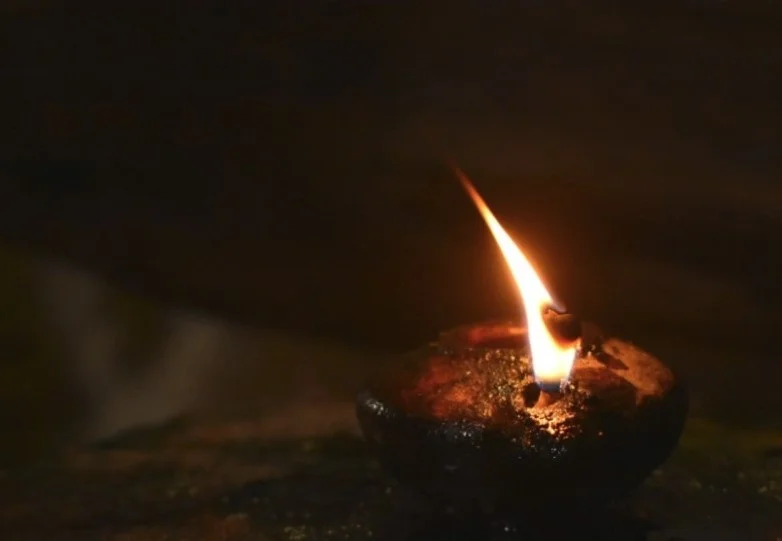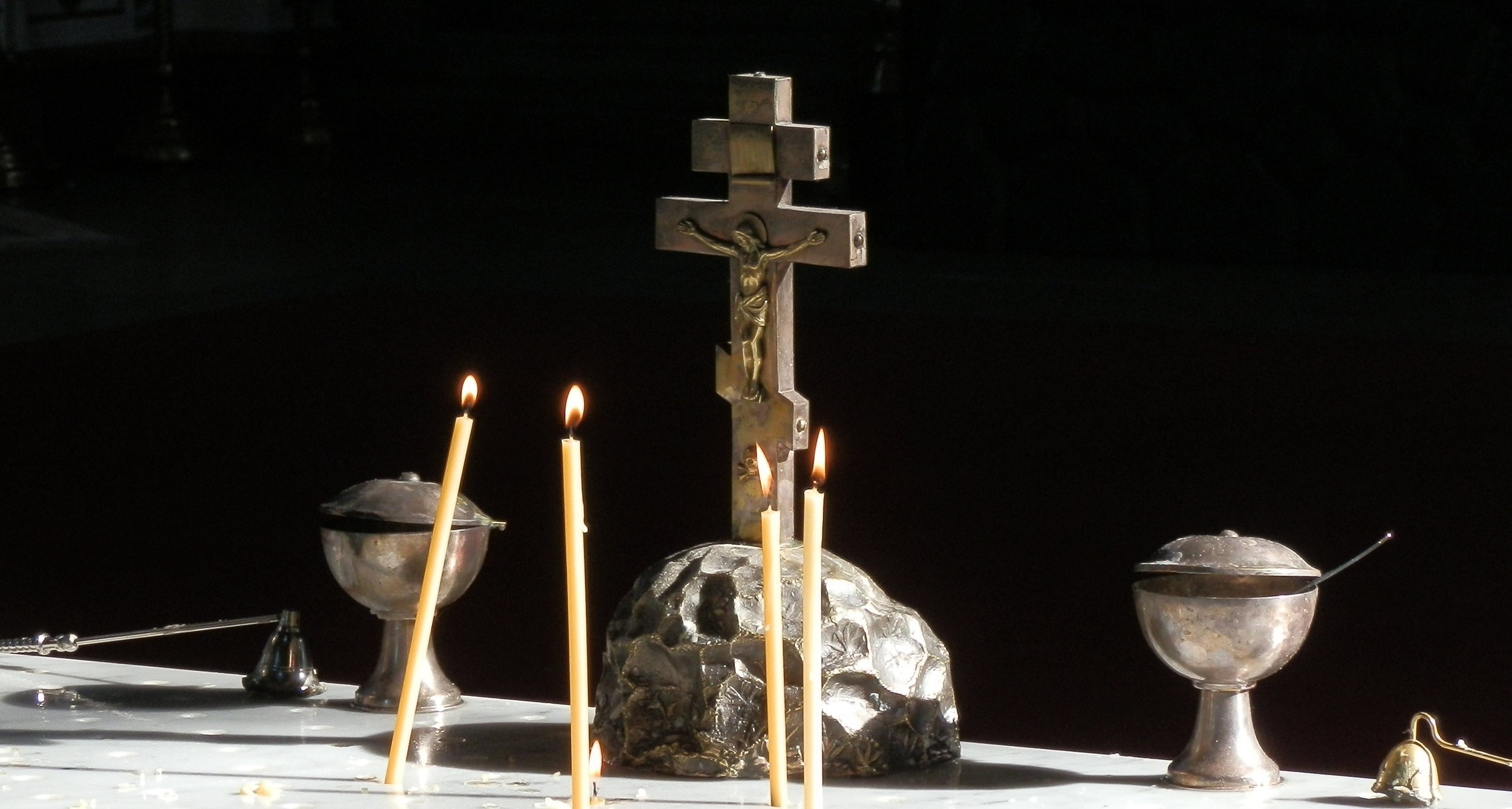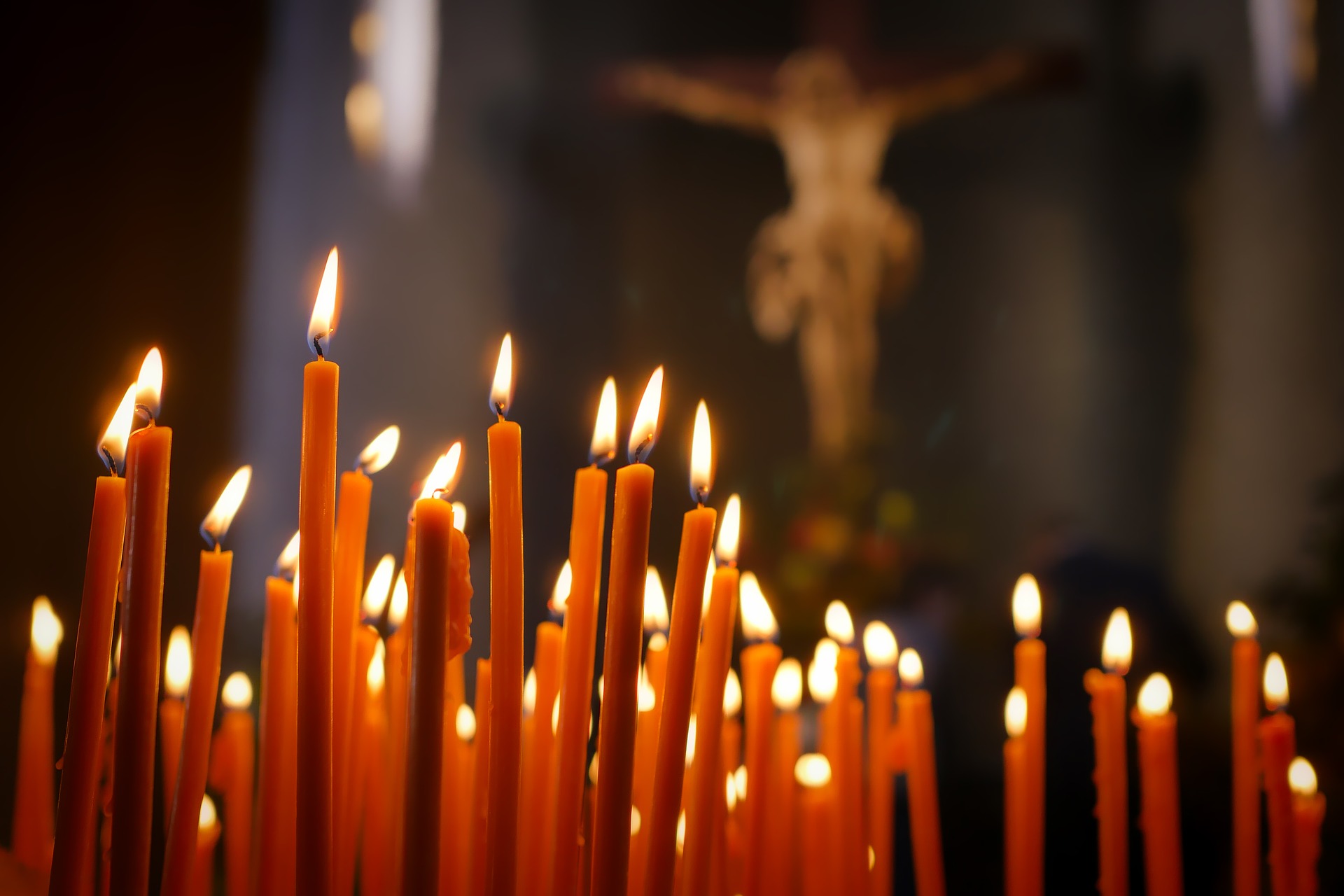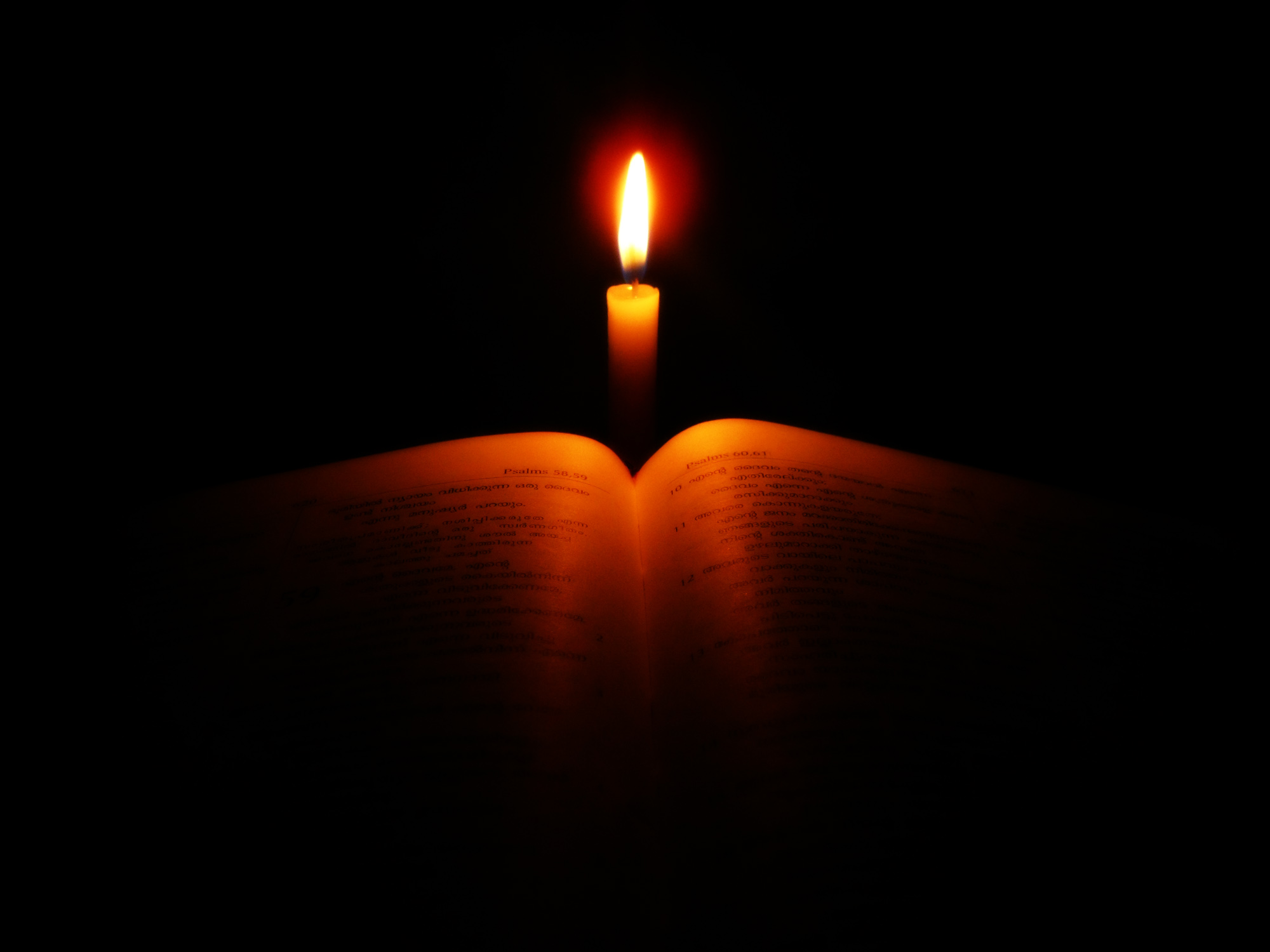Healing Atonement
Gregory of Nyssa (c.335 - 395 AD)
An old clay oil lamp from Nazareth, Israel. Photo credit: Olivia Armstrong.
Messages and Essays on Gregory of Nyssa
Mako Nagasawa, Beauty's Transformation of the Ugly in Gregory of Nyssa's Life of Moses An essay for Dr. Maximos Constas and Dr. Evie Holmberg, for their respective classes at Holy Cross Greek Orthodox Seminary, Fall 2018; examines Gregory's work (c.390 AD) as a critical engagement with the Platonic tradition, especially Origen and Plotinus; pays special attention to Gregory's statements about Jesus' atonement. For reference, see David Bentley Hart, Mind Over Matter: 'The Enneads'. Commonweal, Jan 16, 2019.
The Writings of Gregory of Nyssa
Gregory of Nyssa, Against Eunomius book 2, chapter 11 says "For it was when He came in the form of a servant to accomplish the mystery of redemption by the cross, Who had emptied Himself, Who humbled Himself by assuming the likeness and fashion of a man [Philippians 2:7-8], being found as man in man's lowly nature — then, I say, it was that He became obedient, even He Who took our infirmities and bare our sicknesses [Matthew 8:17], healing the disobedience of men by His own obedience, that by His stripes He might heal our wound [Isaiah 53:5], and by His own death do away with the common death of all men — then it was that for our sakes He was made obedient, even as He became sin [2 Corinthians 5:21] and a curse [Galatians 3:13] by reason of the dispensation on our behalf, not being so by nature, but becoming so in His love for man."
Gregory of Nyssa, Against Eunomius book 5, chapter 4 says, "We say that the Only-begotten God, having by His own agency brought all things into being, by Himself has full power over all things, while the nature of man is also one of the things that were made by Him: and that when this had fallen away to evil, and come to be in the destruction of death, He by His own agency drew it up once more to immortal life, by means of the Man in whom He tabernacled, taking to Himself humanity in completeness, and that He mingled His life-giving power with our mortal and perishable nature, and changed, by the combination with Himself, our deadness to living grace and power. And this we declare to be the mystery of the Lord according to the flesh, that He Who is immutable came to be in that which is mutable, to the end that altering it for the better, and changing it from the worse, He might abolish the evil which is mingled with our mutable condition, destroying the evil in Himself. For our God is a consuming fire [Hebrews 12:29], by whom all the material of wickedness is done away."
Gregory of Nyssa, Against Eunomius book 6, chapter 1 God condemned sin ‘in the flesh,’ not ‘in the Godhead’; critiques Eunomius and, from that angle, forecloses on penal substitution
Gregory of Nyssa, Against Eunomius book 12, chapter 1 says, "Since then it was impossible that our life, which had been estranged from God, should of itself return to the high and heavenly place, for this cause, as says the Apostle, He Who knew no sin is made sin for us, and frees us from the curse by taking on Him our curse as His own, and having taken up, and, in the language of the Apostle, slain in Himself the enmity which by means of sin had come between us and God —(in fact sin was the enmity) — and having become what we were, He through Himself again united humanity to God."
Gregory of Nyssa, Great Catechism chapters 8, 9, 15, 24 - 27, 29 - 32, 35, 37, 40. See translation by William Moore, The Great Catechism by Gregory of Nyssa. Catholic Culture.
Gregory of Nyssa, Epistle 1 says, "we keep the feast of the appearing of the true Light divine, that through the veil of flesh has cast its bright beams upon the life of men: but now when that luminary has traversed half the heaven in his course, so that night and day are of equal length, the upward return of human nature from death to life is the theme of this great and universal festival, which all the life of those who have embraced the mystery of the Resurrection unites in celebrating"
Gregory of Nyssa, Epistle 17 says, "It is for this reason that Holy Writ records unabashed with regard to Him all the accidents of our nature, even eating, drinking, sleeping, weariness, nurture, increase in bodily stature, growing up — everything that marks humanity, except the tendency to sin. Sin, indeed, is a miscarriage, not a quality of human nature: just as disease and deformity are not congenital to it in the first instance, but are its unnatural accretions, so activity in the direction of sin is to be thought of as a mere mutilation of the goodness innate in us; it is not found to be itself a real thing, but we see it only in the absence of that goodness. Therefore He Who transformed the elements of our nature into His divine abilities, rendered it secure from mutilation and disease, because He admitted not in Himself the deformity which sin works in the will. He did no sin, it says, neither was guile found in his mouth [1 Peter 2:22]. And this in Him is not to be regarded in connection with any interval of time: for at once the man in Mary (where Wisdom built her house), though naturally part of our sensuous compound, along with the coming upon her of the Holy Ghost, and her overshadowing with the power of the Highest, became that which that overshadowing power in essence was: for, without controversy, it is the Less that is blest by the Greater. Seeing, then, that the power of the Godhead is an immense and immeasurable thing, while man is a weak atom, at the moment when the Holy Ghost came upon the Virgin, and the power of the Highest overshadowed her, the tabernacle formed by such an impulse was not clothed with anything of human corruption; but, just as it was first constituted, so it remained, even though it was man, Spirit nevertheless, and Grace, and Power; and the special attributes of our humanity derived lustre from this abundance of Divine Power." Here Gregory seems to take back what he says elsewhere about Jesus taking on a fallen human nature. Significantly, he seems to be referring to sexual concupiscence here, joining Tertullian and Augustine in the belief that sexual desire in a husband and wife transmits something corrupt into the child thus conceived. It is possible that he was confining his meaning to this.
Gregory of Nyssa, On the Soul and Resurrection see distillation by Andrew Arndt, Gregory of Nyssa on the Purification of the Soul (blog, Jan 11, 2019)
Gregory of Nyssa, Address on Religious Instruction, chapters 27 - 28 (pdf file), p.305 - 307
Gregory of Nyssa, Sermon on the Baptism of Christ says, “Christ, then, was born as it were a few days ago—He Whose generation was before all things, sensible and intellectual. Today He is baptized by John that He might cleanse him who was defiled, that He might bring the Spirit from above, and exalt man to heaven, that he who had fallen might be raised up and he who had cast him down might be put to shame. And marvel not if God showed so great earnestness in our cause: for it was with care on the part of him who did us wrong that the plot was laid against us; it is with forethought on the part of our Maker that we are saved. And he, that evil charmer, framing his new device of sin against our race, drew along his serpent train, a disguise worthy of his own intent, entering in his impurity into what was like himself,—dwelling, earthly and mundane as he was in will, in that creeping thing. But Christ, the repairer of his evil-doing, assumes manhood in its fulness, and saves man, and becomes the type and figure of us all, to sanctify the first-fruits of every action, and leave to His servants no doubt in their zeal for the tradition.”
Gregory of Nyssa, The Life of Moses, book 2, paragraphs 29 - 34 says, "When he was manifested to us from the bosom of the Father, he was changed to be like us. After he wiped away our infirmities, he again returned to his own bosom the hand which had been among us and had received our complexion. (The Father is the bosom of the right hand.) What is impassible by nature did not change into what is passible, but what is mutable and subject to passions was transformed into impassibility through its participation in the immutable... For if the father of sin is called a serpent by Holy Scripture and what is born of the serpent is certainly a serpent, it follows that synonymous with the one who begot it. But the apostolic word testifies that the Lord was made into sin for our sake by being invested with our sinful nature. This figure is rightly applied to the Lord. For if sin is a serpent and the Lord became sin, the logical conclusion should be evident to all: By becoming sin he became also a serpent, which is nothing other than sin. For our sake he became a serpent that he might devour and consume the Egyptian serpents produced by the sorcerers. This done, the serpent was changed back into a rod by which sinners are brought to their senses..." Patrick F. O'Connell, "The Double Journey in Saint Gregory of Nyssa: The Life of Moses," writes, "Gregory's point is that Jesus took upon himself not human nature in the abstract, but as it actually is, subject to physical and moral corruption." (p.306)
Gregory of Nyssa, The Life of Moses, book 2, paragraphs 178, 187 interpreting allegorically the Exodus tabernacle to Jesus, "The veil of the lower tabernacle is the flesh [of Christ]," and, "The reddened skin and hairy hides, which contribute to the decoration of the tabernacle, may be interpreted respectively as the death of sinful flesh of which the reddened skin is a symbol, and the severe life of self-control, by which the tabernacle of the church is especially beautified. For skins which in themselves do not naturally have the power of life become flushed by the dipping in red dye, which teaches that the grace which flourishes through the Spirit is only found in people who make themselves dead to sin."
Gregory of Nyssa, The Life of Moses, book 2, paragraph 216 says, "But again the true Lawgiver, of whom Moses was a type, cut the tables of human nature for himself from our earth. It was not marriage which produced for him his "God-receiving" flesh, but he became the stonecutter of his own flesh, which was carved by the divine finger, for the Holy Spirit came upon the virgin and the power of the Most High overshadowed her. When this took place, our nature regained its unbroken character, becoming immortal through the letters written by his finger. The Holy Spirit is called "finger" in many places by Scripture."
Gregory of Nyssa, The Life of Moses, book 2, paragraphs 275 - 277 says, "Since therefore unruly desire brought forth the deadly serpents from the earth (for every offspring of evil desire is a serpent), the Law prefigures for us what is clear in the wood. This figure is a likeness of a serpent and not a serpent itself, as the great Paul himself says, in the likeness of sinful flesh [Romans 8:3]. Sin is the real serpent, and whoever deserts to sin takes on the nature of the serpent. Man, then, is freed from sin through him who assumed the form of sin and became like us who had turned into the form of the serpent..."
More Resources on Gregory of Nyssa
Gregory of Nyssa, The Life of Moses. A pdf copy.
Michael Azkoul, St. Gregory of Nyssa and the Tradition of the Fathers (1995). A pdf copy, a helpful resource comparing Gregory with Philo, Origen, and Plotinus.
T.F. Torrance, Theology in Reconciliation. Wipf and Stock | Amazon page, 1996. See p.154 - 156
Orthodox Prayer, Life of Saint Gregory of Nyssa. Orthodox Prayer. Gives a good summary, with ample footnotes
Robert (Robin) Michael Orton, Garments of Light, Tunics of Skin, and the Body of Christ: St. Gregory of Nyssa’s Doctrine of the Body. British Library eThOS | PhD dissertation, King’s College, University of London 2009. Orton concludes that while Gregory attempted to explain the coherence of creation, the human body, atonement, and resurrection, he did not fully succeed. This substantiates my argument that we must return to Irenaeus of Lyons’ doctrine of the body, because the influence of Origen on defining body and soul was detrimental to Christian theology.
David Bradshaw, No Repentance After Death: Facing Hard Questions about Salvation. Orthodoxy and Heterodoxy | Ancient Faith, May 26, 2020. Bradshaw examines Clement of Alexandria, Gregory of Nyssa, John Chrysostom, Theophylact, Dorotheus of Gaza, Dionysius the Areopagite, and Maximus the Confessor.
Father John Behr, Reason Persuading Necessity: Gregory of Nyssa on the Human Being. Sheptytsky Institute, Jul 16, 2022. Behr gives an excellent lecture. Gregory of Nyssa has a fairly developed theologically anthropology of human being and human becoming, though he also believed God created a human “pleroma” involving the totality of human persons being the “image” of God. See also Father Chrysostom MacDonnell, Science and Orthodox Christianity. Antiochian Orthodox Christian Archdiocese of the British Isles and Ireland, Apr 5, 2022. MacDonnell takes the mystical or allegorical interpretation of the creation story to mean not a physical and temporal history, but an idealist or spiritual-archetypal one. This was the approach of Gregory of Nyssa and Maximus the Confessor, although the groundwork was laid by Origen of Alexandria.
Sources of Atonement Theology
These resources explore the foundation of “Medical Substitution” as the best understanding of the Bible, and the original understanding of the church. There are also links to books, web articles, etc. from representatives of the three broad Christian traditions.





